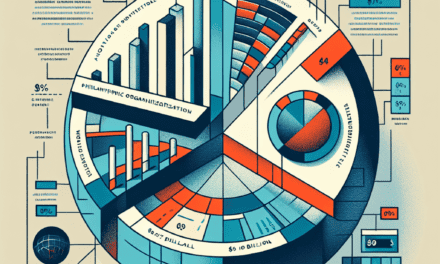“Rising Futures, Sinking Yields: Navigating the Weekly Market Dip”
Introduction
Futures markets are experiencing an upward trajectory as falling Treasury yields provide a boost, despite major indexes facing a potential weekly decline. The drop in yields is offering some relief to investors, who are navigating a complex landscape of economic indicators and market sentiment. This dynamic is unfolding against a backdrop of broader market volatility, where concerns over inflation, monetary policy, and global economic conditions continue to influence trading decisions. As futures climb, market participants are closely monitoring these developments to gauge the potential impact on investment strategies and portfolio performance.
Impact Of Falling Treasury Yields On Stock Market Futures
In recent financial developments, stock market futures have experienced an upward trajectory, largely influenced by the decline in Treasury yields. This dynamic interplay between Treasury yields and stock market futures is a critical aspect of financial markets, as it reflects investor sentiment and broader economic conditions. As Treasury yields fall, borrowing costs decrease, which can stimulate economic activity by making it cheaper for businesses and consumers to borrow money. This, in turn, can lead to increased corporate profits and consumer spending, factors that are generally favorable for stock markets.
The decline in Treasury yields often signals a shift in investor preference from fixed-income securities to equities. When yields fall, the returns on bonds become less attractive, prompting investors to seek higher returns in the stock market. This shift can lead to an increase in demand for stocks, driving futures higher. Moreover, lower yields can also indicate expectations of slower economic growth or potential monetary policy easing by central banks, both of which can have significant implications for stock market performance.
Despite the recent climb in futures, major indexes are facing a weekly decline, highlighting the complex and often volatile nature of financial markets. Several factors contribute to this dichotomy. For instance, geopolitical tensions, economic data releases, and corporate earnings reports can all influence market sentiment and lead to fluctuations in stock prices. Additionally, while falling Treasury yields can be beneficial for stocks, they may also reflect underlying economic concerns that could weigh on market performance.
Investors must navigate these complexities by carefully analyzing the interplay between Treasury yields and stock market futures. Understanding the reasons behind yield movements is crucial for making informed investment decisions. For example, if yields are falling due to expectations of an economic slowdown, investors might be more cautious about equity investments despite the initial boost to futures. Conversely, if yields are declining due to anticipated monetary policy easing, this could be seen as a positive signal for stocks, as lower interest rates can support economic growth and corporate profitability.
Furthermore, the relationship between Treasury yields and stock market futures is not always straightforward. Various external factors, such as inflation expectations, fiscal policy changes, and global economic conditions, can also impact this relationship. As such, investors must remain vigilant and adaptable, continuously assessing how these factors might influence market dynamics.
In conclusion, the recent climb in stock market futures amid falling Treasury yields underscores the intricate and multifaceted nature of financial markets. While lower yields can provide a boost to equities by reducing borrowing costs and encouraging investment, they may also reflect broader economic concerns that could pose challenges for market performance. As major indexes face a weekly decline, investors must carefully consider the underlying factors driving these trends and remain attuned to the ever-evolving financial landscape. By doing so, they can better position themselves to navigate the complexities of the market and make informed investment decisions that align with their financial goals.
Analyzing The Weekly Decline In Major Indexes
In the ever-evolving landscape of financial markets, the interplay between various economic indicators often dictates the trajectory of major indexes. This week, a notable development has been the rise in futures, juxtaposed against the backdrop of falling Treasury yields. Despite this upward movement in futures, major indexes are on track to register a weekly decline, a phenomenon that warrants a closer examination to understand the underlying dynamics at play.
To begin with, the decline in Treasury yields has been a significant factor influencing market sentiment. Typically, falling yields suggest a shift in investor preference towards safer assets, often driven by concerns over economic growth or geopolitical uncertainties. This week, the decline in yields can be attributed to a combination of factors, including softer economic data and dovish signals from central banks. As yields fall, borrowing costs decrease, which can stimulate economic activity by encouraging investment and spending. However, the immediate reaction in equity markets has been mixed, as investors weigh the benefits of lower yields against the potential reasons for their decline.
In parallel, futures have climbed, reflecting a degree of optimism among investors. This optimism may stem from expectations of continued accommodative monetary policy, which could support asset prices in the near term. Additionally, corporate earnings reports have been a mixed bag, with some sectors outperforming expectations while others lag behind. The divergence in earnings results has contributed to the volatility observed in major indexes, as investors reassess their portfolios in light of new information.
Despite the rise in futures, major indexes are poised to end the week in negative territory. This decline can be attributed to several interrelated factors. Firstly, the ongoing concerns about inflationary pressures continue to weigh on investor sentiment. While central banks have reiterated their commitment to managing inflation, the persistence of supply chain disruptions and rising commodity prices has fueled fears of sustained inflation, which could erode corporate profit margins and consumer purchasing power.
Moreover, geopolitical tensions have added another layer of complexity to the market environment. Uncertainties surrounding trade policies, international relations, and regional conflicts have heightened risk aversion among investors, prompting a cautious approach to equity markets. This cautious sentiment is reflected in the weekly decline of major indexes, as market participants seek to mitigate potential downside risks.
Furthermore, the rotation from growth-oriented stocks to value stocks has been a recurring theme in recent weeks. As investors adjust their strategies in response to changing economic conditions, sectors such as technology, which have been the darlings of the market in recent years, have experienced increased volatility. Conversely, sectors that are perceived as more resilient in an inflationary environment, such as energy and financials, have garnered increased attention.
In conclusion, the interplay between falling Treasury yields and climbing futures highlights the complex dynamics influencing major indexes this week. While the decline in yields has provided some support to market sentiment, the broader concerns about inflation, geopolitical tensions, and sectoral rotations have contributed to the weekly decline in major indexes. As investors navigate this challenging environment, the focus will likely remain on economic data releases, central bank communications, and geopolitical developments, all of which will play a crucial role in shaping market trends in the weeks to come.
Relationship Between Treasury Yields And Market Volatility
The intricate relationship between Treasury yields and market volatility is a subject of perennial interest to investors and economists alike. As futures climb amid falling Treasury yields, it is essential to understand how these dynamics interplay and influence broader market trends. Treasury yields, which represent the return on investment for U.S. government bonds, are often seen as a barometer for economic health and investor sentiment. When yields fall, it typically signals that investors are seeking the relative safety of government bonds, often due to concerns about economic growth or geopolitical uncertainties. This flight to safety can lead to increased demand for bonds, driving prices up and yields down.
Conversely, lower Treasury yields can also make equities more attractive, as the opportunity cost of investing in stocks decreases. This shift can lead to a rise in stock futures, as investors anticipate higher returns from equities compared to the diminishing yields on bonds. However, this relationship is not always straightforward. While falling yields can buoy stock markets in the short term, they may also reflect underlying economic weaknesses that could pose risks to corporate earnings and, by extension, stock prices.
Moreover, the current scenario where futures are climbing despite falling Treasury yields suggests a complex interplay of factors. Investors may be optimistic about certain sectors or companies, driving futures higher even as they remain cautious about the broader economic outlook. This cautious optimism can be attributed to various factors, such as expectations of central bank interventions, fiscal policy measures, or positive corporate earnings reports. However, it is crucial to note that while futures may be climbing, major indexes are facing a weekly decline, highlighting the inherent volatility and uncertainty in the market.
This apparent contradiction underscores the nuanced relationship between Treasury yields and market volatility. On one hand, declining yields can provide a temporary boost to stock markets by making equities more appealing. On the other hand, persistent declines in yields may signal deeper economic issues that could eventually weigh on market performance. This duality is a testament to the complexity of financial markets, where multiple variables interact in unpredictable ways.
Furthermore, the relationship between Treasury yields and market volatility is also influenced by external factors such as geopolitical tensions, changes in monetary policy, and global economic conditions. For instance, geopolitical events can lead to sudden shifts in investor sentiment, causing both Treasury yields and stock markets to fluctuate rapidly. Similarly, changes in monetary policy, such as interest rate adjustments by central banks, can have significant implications for both bond and equity markets.
In conclusion, the relationship between Treasury yields and market volatility is a multifaceted one, shaped by a myriad of factors that can lead to seemingly contradictory market movements. As futures climb amid falling Treasury yields, investors must remain vigilant and consider the broader economic context to navigate the complexities of the financial landscape. Understanding this relationship is crucial for making informed investment decisions and managing risk in an ever-evolving market environment. While the current scenario presents both opportunities and challenges, it serves as a reminder of the intricate dynamics that underpin financial markets and the importance of staying attuned to the myriad factors that influence them.
Strategies For Investors Amid Climbing Futures And Declining Indexes

In the ever-evolving landscape of financial markets, investors are constantly seeking strategies to navigate the complexities of climbing futures and declining indexes. As futures climb amid falling Treasury yields, it becomes imperative for investors to reassess their portfolios and adapt to the shifting dynamics. Understanding the interplay between these elements can provide valuable insights for making informed investment decisions.
To begin with, the rise in futures often signals investor optimism about the future performance of the market. This optimism can be attributed to various factors, such as positive economic indicators, corporate earnings reports, or geopolitical developments. However, when juxtaposed with declining indexes, it suggests a divergence that requires careful analysis. Investors must consider whether the optimism reflected in futures is sustainable or if it is merely a short-term reaction to transient events.
One strategy to consider in this scenario is diversification. By spreading investments across different asset classes, sectors, and geographic regions, investors can mitigate risks associated with market volatility. Diversification allows for a balanced approach, reducing the impact of any single asset’s poor performance on the overall portfolio. As futures climb, it may be tempting to concentrate investments in sectors showing immediate promise. However, maintaining a diversified portfolio ensures resilience against unforeseen downturns in specific areas.
Moreover, the decline in Treasury yields presents another layer of complexity. Lower yields often indicate a flight to safety, as investors seek refuge in government bonds amid uncertainty. This trend can lead to a reallocation of assets, with investors moving away from equities and into fixed-income securities. In such a climate, it is crucial for investors to evaluate the risk-reward profile of their portfolios. While bonds may offer stability, they also come with lower returns compared to equities. Balancing the need for security with the pursuit of growth is essential in crafting a robust investment strategy.
Additionally, investors should remain vigilant about macroeconomic indicators and central bank policies. Interest rate decisions, inflation data, and employment figures can significantly influence market sentiment and, consequently, the performance of futures and indexes. Staying informed about these factors enables investors to anticipate potential market shifts and adjust their strategies accordingly. For instance, if inflation is expected to rise, investors might consider allocating more resources to assets that traditionally perform well in inflationary environments, such as commodities or real estate.
Furthermore, adopting a long-term perspective can be advantageous in navigating periods of market volatility. While short-term fluctuations in futures and indexes can be unsettling, maintaining a focus on long-term goals helps investors avoid making impulsive decisions based on temporary market conditions. By setting clear investment objectives and adhering to a disciplined approach, investors can weather the ups and downs of the market with greater confidence.
In conclusion, the interplay between climbing futures and declining indexes amid falling Treasury yields presents both challenges and opportunities for investors. By employing strategies such as diversification, evaluating risk-reward profiles, staying informed about macroeconomic trends, and maintaining a long-term perspective, investors can position themselves to navigate this complex landscape effectively. As the financial markets continue to evolve, adaptability and informed decision-making remain key to achieving investment success.
Economic Indicators Influencing Treasury Yields And Market Trends
In recent weeks, the financial markets have been characterized by a complex interplay between various economic indicators, with particular attention on the movement of Treasury yields and their subsequent impact on futures and stock indexes. As Treasury yields have experienced a decline, futures have shown an upward trajectory, although major indexes are still grappling with the prospect of a weekly decline. This dynamic underscores the intricate relationship between economic indicators and market trends, which investors and analysts closely monitor to make informed decisions.
To begin with, Treasury yields are often seen as a barometer of investor sentiment and economic health. When yields fall, it typically signals that investors are seeking the relative safety of government bonds, often due to concerns about economic growth or geopolitical uncertainties. This flight to safety can be triggered by a variety of factors, including disappointing economic data, shifts in monetary policy, or global events that heighten risk aversion. In the current scenario, the decline in Treasury yields suggests that investors are cautious, possibly due to mixed economic signals and ongoing debates about the future trajectory of interest rates.
As Treasury yields decrease, the cost of borrowing becomes cheaper, which can stimulate economic activity by encouraging spending and investment. This environment can be favorable for equities, as lower yields make stocks more attractive relative to bonds. Consequently, futures have climbed, reflecting optimism about potential gains in the stock market. However, this optimism is tempered by the reality that major indexes are still facing a weekly decline, highlighting the volatility and uncertainty that continue to pervade the markets.
The interplay between Treasury yields and stock market performance is further complicated by the Federal Reserve’s monetary policy stance. The central bank’s decisions on interest rates are closely watched, as they have a direct impact on both bond yields and equity valuations. In recent months, the Fed has signaled a cautious approach, balancing the need to curb inflation with the desire to support economic growth. This delicate balancing act has contributed to fluctuations in Treasury yields, as market participants attempt to anticipate the Fed’s next moves.
Moreover, economic indicators such as employment data, inflation rates, and consumer confidence play a crucial role in shaping market trends. For instance, stronger-than-expected job growth or rising consumer spending can bolster investor confidence, leading to higher stock prices and potentially offsetting the impact of falling Treasury yields. Conversely, signs of economic slowdown or persistent inflationary pressures can exacerbate market volatility, as investors reassess their risk exposure.
In addition to domestic factors, global economic conditions also influence Treasury yields and market trends. Developments in major economies, such as changes in trade policies, fiscal measures, or geopolitical tensions, can have ripple effects across global financial markets. As a result, investors must remain vigilant, considering both domestic and international factors when evaluating market conditions.
In conclusion, the current landscape of falling Treasury yields and climbing futures, juxtaposed with the potential for weekly declines in major indexes, reflects the complex and interconnected nature of economic indicators and market trends. As investors navigate this challenging environment, they must weigh a multitude of factors, from monetary policy and economic data to global developments, to make informed decisions. Understanding these dynamics is essential for anticipating market movements and managing investment risks effectively.
Historical Context: Treasury Yields And Their Effect On Market Performance
The relationship between treasury yields and market performance has long been a subject of interest for investors and economists alike. Historically, treasury yields, which represent the return on investment for U.S. government bonds, have served as a barometer for economic health and investor sentiment. When treasury yields fall, it often signals a shift in investor preference towards safer assets, reflecting concerns about economic growth or geopolitical uncertainties. Conversely, rising yields typically indicate confidence in economic expansion, prompting investors to seek higher returns in riskier assets such as equities.
In recent times, the dynamics between treasury yields and market performance have become increasingly complex. As futures climb amid falling treasury yields, it is essential to understand the historical context that underpins this relationship. Traditionally, lower yields have been associated with a flight to safety, where investors flock to government bonds, driving prices up and yields down. This scenario often coincides with a decline in stock market performance, as investors anticipate slower economic growth and reduced corporate earnings.
However, the current market environment presents a nuanced picture. While treasury yields have been on a downward trajectory, signaling caution among investors, stock futures have shown resilience, suggesting a divergence from historical patterns. This anomaly can be attributed to several factors, including the unprecedented monetary policies implemented by central banks worldwide. In response to economic challenges, central banks have maintained low interest rates and engaged in quantitative easing, injecting liquidity into the financial system. This influx of capital has buoyed stock markets, even as traditional indicators like treasury yields suggest caution.
Moreover, the interplay between treasury yields and market performance is further complicated by the global economic landscape. In an interconnected world, geopolitical tensions, trade disputes, and pandemic-related disruptions have introduced new variables that influence investor behavior. As a result, the historical correlation between falling yields and declining stock markets has weakened, with investors increasingly relying on a broader set of indicators to gauge market sentiment.
Despite the current resilience in stock futures, it is important to acknowledge that major indexes face a potential weekly decline. This underscores the inherent volatility and uncertainty that characterize today’s financial markets. Investors must navigate a complex web of factors, balancing the implications of falling treasury yields with other economic indicators and market signals. In this context, understanding the historical relationship between treasury yields and market performance provides valuable insights, but it is equally crucial to adapt to the evolving landscape.
In conclusion, the historical context of treasury yields and their effect on market performance offers a foundational understanding of investor behavior and economic sentiment. While falling yields have traditionally been associated with declining stock markets, the current environment presents a more intricate picture. The resilience of stock futures amid falling yields highlights the influence of central bank policies and global economic dynamics. As major indexes face potential weekly declines, investors must remain vigilant, considering a wide array of factors to make informed decisions. By appreciating the historical context and adapting to contemporary challenges, investors can better navigate the complexities of today’s financial markets.
Expert Predictions: Future Trends In Treasury Yields And Stock Market Movement
As the financial markets navigate a complex landscape, recent developments have seen futures climbing amid falling Treasury yields, even as major indexes face a potential weekly decline. This dynamic interplay between Treasury yields and stock market movements has captured the attention of investors and analysts alike, prompting a closer examination of future trends in these critical areas. Understanding the underlying factors driving these changes is essential for making informed predictions about the trajectory of Treasury yields and stock market performance.
To begin with, the decline in Treasury yields can be attributed to several key factors. Primarily, economic data releases have painted a mixed picture of the U.S. economy, with some indicators suggesting a slowdown in growth. This has led to increased speculation that the Federal Reserve may adopt a more dovish stance, potentially slowing the pace of interest rate hikes. As a result, investors have flocked to the relative safety of government bonds, driving yields lower. Additionally, geopolitical tensions and global economic uncertainties have further fueled demand for Treasuries, reinforcing the downward pressure on yields.
In contrast, the stock market’s response to falling Treasury yields has been somewhat paradoxical. While lower yields typically make equities more attractive by reducing borrowing costs and increasing the present value of future earnings, the current environment has seen major indexes struggle to maintain upward momentum. This can be attributed to concerns over corporate earnings growth, as companies grapple with rising input costs and supply chain disruptions. Moreover, the specter of inflation continues to loom large, complicating the outlook for both monetary policy and corporate profitability.
Looking ahead, expert predictions suggest that Treasury yields may remain subdued in the near term, particularly if economic data continues to point towards a deceleration in growth. However, any signs of a robust economic recovery or a shift in the Federal Reserve’s policy stance could trigger a reversal in this trend. In such a scenario, yields could rise as investors adjust their expectations for future interest rate hikes. This would likely have a ripple effect on the stock market, potentially leading to increased volatility as market participants reassess their risk appetite.
Furthermore, the interplay between Treasury yields and stock market movements is expected to remain a focal point for investors. As yields fluctuate, they will continue to influence asset allocation decisions, with implications for both equity and fixed-income markets. In particular, sectors that are sensitive to interest rate changes, such as financials and real estate, may experience heightened volatility as investors react to shifts in yield expectations.
In conclusion, the current environment presents a complex tapestry of factors influencing Treasury yields and stock market movements. While futures have climbed amid falling yields, the potential for a weekly decline in major indexes underscores the challenges facing investors. As experts weigh in on future trends, it is clear that the path forward will be shaped by a delicate balance of economic data, monetary policy, and global developments. By staying attuned to these dynamics, investors can better navigate the uncertainties ahead and position themselves for potential opportunities in the evolving financial landscape.
Q&A
1. **What are futures?**
Futures are financial contracts obligating the buyer to purchase, or the seller to sell, an asset at a predetermined future date and price.
2. **Why do futures climb when Treasury yields fall?**
Futures often climb when Treasury yields fall because lower yields can make equities more attractive compared to bonds, leading to increased demand for stocks.
3. **What are Treasury yields?**
Treasury yields are the return on investment, expressed as a percentage, on the U.S. government’s debt obligations, such as bonds and notes.
4. **How do falling Treasury yields impact the stock market?**
Falling Treasury yields can lead to lower borrowing costs for companies and consumers, potentially boosting economic activity and making stocks more appealing.
5. **What does it mean for indexes to face a weekly decline?**
Indexes facing a weekly decline means that the overall value of the stock market indices, such as the S&P 500 or Dow Jones, has decreased over the course of the week.
6. **What factors can cause Treasury yields to fall?**
Treasury yields can fall due to factors such as increased demand for bonds, expectations of lower inflation, or central bank policies aimed at reducing interest rates.
7. **How do investors typically react to falling Treasury yields?**
Investors may shift their portfolios towards equities and other riskier assets in search of higher returns when Treasury yields fall.
Conclusion
Futures markets are experiencing an upward trend as falling Treasury yields provide a more favorable environment for equities, suggesting increased investor confidence or a shift towards riskier assets. Despite this positive movement in futures, major stock indexes are still on track for a weekly decline, indicating that broader market concerns or previous losses have not been fully offset by the recent gains in futures. This scenario reflects a complex market environment where short-term optimism is tempered by underlying challenges or uncertainties affecting overall market performance.





